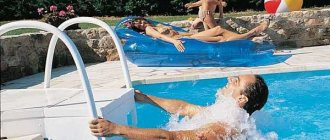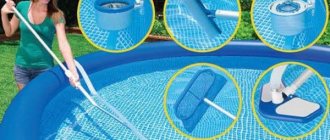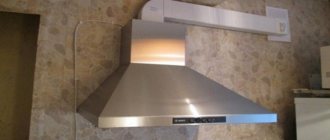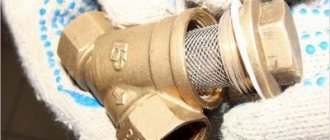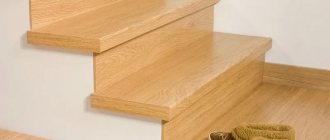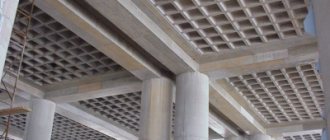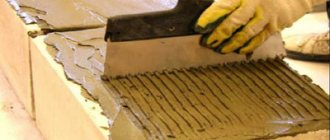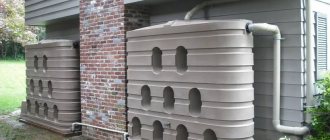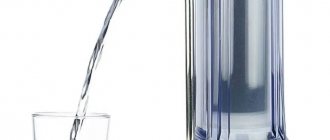Heat exchanger for a swimming pool: operating principle and power calculation
The water in the pool needs to be at a comfortable temperature, all the time. No direct-acting heater can heat such a large volume of liquid, and evenly.
It is necessary to warm up a large volume of water and constantly replenish heat losses, which in a pool are considerable only due to the large surface area.
The heat source can be a heating boiler, solar panels or geothermal heat, and to transfer the heat to the water you will need a pool heat exchanger.
The easiest way to heat a pool is to place a heat exchanger in series with filters and a circulation pump, which constantly pumps liquid from the bottom drain and skimmer and returns it back through the nozzles located around the perimeter of the bowl. Thus, the water in the pool does not stagnate and is regularly cleaned and heated. There is no additional equipment in the tank itself; everything is taken outside of it and is most often placed below ground level in a special caisson.
Principle of operation
The heat exchanger itself does not heat the water. It is only an optimized device for effective heat exchange between two media. One of them is the coolant from the direct heat source, and the second is just water from the pool.
In a heat exchanger, the two media are separated only by thin walls of pipes or plates with high thermal conductivity. The higher the area of such contact, the more heat will have time to transfer from the hotter liquid to the colder one.
In essence, the heat exchanger is always in-line, although the volume of chambers and sections for pumping two media may differ significantly. Tubular and plate heat exchangers are used for swimming pools. The advantage is on the side of tubular devices, since they reduce the resistance to water flow introduced by the device and are less demanding on the purity of the pumped liquid.
The housing forms the first chamber for the heated liquid. This is an oblong cylinder made of a large diameter pipe, closed at both ends with plugs that have fittings for connecting pipes. It is insulated on top to eliminate unnecessary heat loss.
Tubes are distributed inside the housing, isolated from the internal space of the device, with fittings located on the outside.
The tube can be one curved in a spiral to increase the contact area and stretching from one edge of the heat exchanger to the other. But it is more efficient to use many tubes in parallel, which are connected at the ends by a manifold.
This significantly reduces the hydraulic resistance of the heat exchanger to the coolant circuit and increases the contact area and boundaries between the two liquids.
Main characteristics of the heat exchanger:
- Maximum operating temperature. The maximum heating of the coolant that the device can withstand.
- Thermal power. It depends not only on the contact area, but also on the type of liquid in both circuits and the temperature difference.
- Throughput, measured in cubic meters per hour, determines how long it takes the entire volume of the pool to pass through the heat exchanger.
Power calculation
The selection of heat exchanger power for a swimming pool is carried out based on four factors:
- Size of the pool, volume of constant heat loss;
- Coolant temperature and heat source power;
- Target pool water temperature;
- The time it takes to heat water, provided that it has just been filled.
The goal is not to heat the entire volume of water in the pool bowl as quickly as possible. The heat exchanger capacity is sufficient at a level equal to the maximum constant heat loss so that the temperature can be maintained at a given level.
The lower limit for power selection is taken to be approximately 0.7 of the volume of the pool bowl, or more precisely, water when completely filled. This is an approximate value of heat loss due to evaporation and heat exchange with the walls of the bowl.
Exceeding this threshold determines the time during which the heat exchanger can warm up only the collected cold water and most often this parameter is set to 1-3 days.
A heating boiler is used as a heat source, working both to heat the house and to heat the pool, or in a small circuit only to heat the pool, for example during a warm period of time. The maximum possible heat output should be determined precisely under the conditions of heating operation in the house, so as not to take away excess heat to maintain the pool.
Required heat exchanger power to heat the pool in a certain time.
P = ((V*С * ΔТ)/t1) + q*S
Where:
P – required heat exchanger power (W),
C – specific heat capacity of water at a temperature of 20°C (W/kg*K);
ΔТ – difference in temperature of cold and hot water (оС),
t1 – optimal time for heating the entire pool (hours),
q – heat loss per hour per square meter of water surface (W/m2),
V – volume of water in the pool (l).
Calculations should take into account heat loss from the water surface due to evaporation. The following values are accepted:
- The pool is completely outdoors - 1000 W/m2.
- Partially covered by a canopy or part of a building - 620 W/m2.
- Fully indoor pool – 520 W/m2.
The obtained value is exactly the parameter that you should first focus on when choosing a heat exchanger. The remaining parameters must be coordinated with the existing equipment.
If you want to divide the operating time of the heat exchanger into night and day, when an electric hot water boiler is used, the power of the heat exchanger must be increased accordingly. It is enough to multiply the previously obtained number by 24 and divide by the number of hours that are supposed to be allocated for heating the pool.
The resistance to water flow should be taken into account when choosing a circulation pump, moreover, together with the filter station, the resistance of pipes, nozzles and all other piping elements.
The maximum permissible temperature in the hot circuit is determined by the nominal temperature produced by the boiler or heating boiler.
From the same formula it is easy to derive the heating time of the pool, knowing the power of the commercially available heat exchanger. There is no need to chase ultra-fast heating; it is enough if the pool warms up from a completely cold state to a comfortable temperature in two days.
Connection
Connection diagram
The heat exchanger is turned on after the filter and circulation pump, but before the dispenser for chemicals, chlorine, fragrance, etc. Connections of both circuits are made only through shut-off valves to allow control of switching on and dismounting for maintenance purposes.
The heating must be controlled by a control valve located at the hot circuit supply from the boiler. It, in turn, is regulated by a thermostat head, in which the temperature sensor is fixed to the outlet pipe of the heated circuit. Using a stationary immersion thermometer with indication, the thermal head settings are set to control the coolant supply.
The heat exchanger for the pool should be installed below the pressure line, in fact below the pipes connected to it, below the filter and air vent, eliminating the ingress and accumulation of air.
Most often, the circuit from the heating boiler to the pool and heat exchanger turns out to be extended. Therefore, an additional circulation pump is installed on the line. For its smooth operation, a bypass should be arranged parallel to the heat exchanger and in front of the control valve. As a result, the heat exchanger constantly monitors the temperature of the pool water and heats it up if necessary.
The best manufacturers
Before buying a VB in an online store, you need to determine which model from which company will perform its functions better. In this matter, recommendations from the owners of such equipment will be a good help. In most cases, they advise purchasing devices from the most well-known companies. They always have good performance characteristics and function reliably for a long time.
The most popular manufacturers:
- Intex (Netherlands);
- TeploMax (Russia);
- Bestway (China);
- Dymoff (Russia);
- Pelletron (Russia);
- PAHLEN (Sweden).
Pool heating from a gas boiler diagram
The ambient temperature greatly influences the water temperature in an outdoor pool.
At an air temperature of 18-20 degrees, a person still feels more or less comfortable, however, few people would want to swim at such a temperature.
Often, such conditions during the warm period in the middle zone and to the north make up the lion's share. In this regard, the issue of heating water in the pool is relevant.
Water temperature standard for swimming poolsPool type Standard water temperature (degrees Celsius)
| Swimming and sports pools | 24-26 |
| Children's pools | 28-30 |
| Hydromassage and spa pools | 32-38 |
To eliminate problems with maintaining the required water temperature, the necessary heating equipment is selected already at the design stage. In this article we will help you get comfortable with this problem and choose the appropriate model based on type and power.
Water heating devices operate on the principle of heat transfer “from hot to cold”. The installations differ in the principle of obtaining heat for heating.
Types and principle of operation of water heaters Type of water heating installation Principle of heat generation
| Recuperative heat exchangers ( a heat exchanger in which hot and cold coolants move in different channels, heat exchange occurs through the wall) | Circulating water heated in any way transfers heat through the walls, heating the water. |
| Electric heaters | Heated by electricity. Heat is transferred to water directly from tubular electric heaters (TEH) |
2. Heat exchangers
A water-to-water heat exchanger consists of a housing, inside of which two circuits are mounted. The primary circuit (heating circuit) is designed to circulate water from the boiler. The secondary circuit is for circulating water from the pool. Heat exchange occurs between the circuits as follows. The pool water picks up heat from the water in the heat exchanger.
The cooled water passes through the boiler again, is heated and returns to the heat exchanger to transfer heat to the water from the pool. And so on in a vicious circle until the water in the pool reaches the set temperature. Then, depending on the settings, the heater either turns off or continues to operate in the mode of maintaining the required temperature.
The time required to heat the water to the set temperature depends on the volume of the pool and the power of the heater.
Type and design features of the heat exchanger Type of heat exchanger Design features
| vertically located | A heating circuit in the form of a bundle of thin tubes, through each of which water flows. A large number of tubes in a bundle increases the heat transfer area. There are designs with a dismantled tube bundle (increasing maintainability). |
| horizontally located | Heating circuit in spiral shape |
The heat exchanger body is made of
- composite plastic,
- of stainless steel,
- titanium.
The heating circuit is made of
- stainless steel (suitable for price/quality ratio for fresh water pools),
- titanium (for seawater pools),
- nickel,
- cupronickel.
Advantages and disadvantages of heat exchangers Advantages Disadvantages
| relatively cheap | To operate, the house must have a gas boiler (an electric boiler is possible, but this is already expensive) |
| do not require large operating costs | At the declared power, the heat exchanger will only operate at the conditions specified in the technical specifications. passport, the difference in temperatures of the primary and secondary circuits and the ratio of fluid velocities in them |
The drop in heater performance in case of deviation from the specification data can be analyzed using graphs (diagram A, B)
Solar collectors (solar batteries)
They are heated by the sun's rays and this heat is used to heat the water in the pool. The collector has a system of thin tubes.
Advantages and disadvantages of solar collectorsAdvantages Disadvantages
| no gas boiler required | low power (a square meter of battery produces thermal energy of 0.6 - 0.9 kW/hour. To cover the power of a weak water-to-water heat exchanger, you will need a battery area equal to the surface area of the pool.) |
| no electricity is wasted | used in the southern latitudes of our Motherland with a lot of sunny days |
Electric heaters
Electric heaters are alternative devices to heat exchangers. Operating principle: a tubular electric heating element (TEH) is placed in the housing. It transfers heat to flowing water. There are no particular differences between the models.
When choosing an electric heater, the guideline is:
- output power,
- the material from which the body is made,
- the material from which the heating element is made.
When using sea water, heating elements are selected from titanium, nickel or cupronickel.
Advantages and disadvantages of electric heatersAdvantages Disadvantages
| for convenience, they are equipped with a thermostat with a display, which makes it easy to adjust the water temperature | huge energy consumption (increased costs for pool maintenance) |
| equipped with an automatic control kit (flow sensor or pressure sensor), which does not allow operation with low water flow | higher power models require a three-phase connection to the network |
| initially equipped with everything necessary for startup and operation |
Installation features
The electric heater is connected to the circuit so that the incoming pipe is directed vertically downwards. In this case, the device will always be filled with water and even if the automation fails, the heating element will not burn out.
Practice shows that electric heaters are used for pools up to 12 cubic meters of open type and up to 20 cubic meters of closed type.
The task of maintaining the required temperature in the pool is not so easy to solve. The formula for calculating the heating time of water does not take into account its important feature - heat loss during evaporation. Because of this, heating the water takes longer, despite the fact that heating already takes a lot of time.
In this regard, the project includes heating aids:
Heat pumps for heating water
A heat pump is designed to cool or heat water in a swimming pool by converting the energy of atmospheric air into heat.
Installed outdoors.
Advantages
- very simple connection - just connect the water and power supply to the heat pump.
— the built-in system automatically sets the optimal operating modes of the compressor and fan to obtain maximum efficiency, by measuring the ratio of air temperature and coolant. Control is carried out by a digital remote control; there are several automatic settings for maintaining the temperature.
— sensors and protection systems : protection against low and high coolant pressure, high coolant temperature sensor, water flow sensor, shutdown system at low air temperatures, automatic defrosting system.
Conclusions:
1. Water-to-water heat exchangers, electric heaters and solar panels are mainly used to heat pool water. The latter option is used mainly as an additional heating source.
2. The choice of model is based on the heater power.
3. A saltwater pool requires a heater made of anti-corrosion materials.
4. It takes a long time to heat up the pool water
The procedure for calculating the operating time of the heat exchanger
Let's estimate the operating time of the heat exchanger for heating the pool. To do this, we will use the empirical formula (without taking into account deviations from the available power and heat losses):
t = 1.16 * V * T / P, where,
t – required time in hours,
V – volume of water in the pool in cubic meters,
T – required temperature difference in degrees,
P – declared power.
Calculation example.
Using this formula, we will calculate in advance the required heating time for your pool with a heat exchanger of the declared power. For example, the water in the pool is 20 degrees, but it needs to be heated to 26 degrees, i.e. by 6 degrees, with a pool volume of 30 cubic meters and a heat exchanger power of 6 kW.
t = 1.16 * 30 * 6 / 6, t = 34.8 hours.
Determining the required heater power
Here are some generalized formulas for the correct selection of a water heater.
Determining the power of the water heater Type and place of use of the water heater The required power of the water heater
| Heat exchanger for outdoor swimming pool (power in kW) | Equal to the volume of the pool (cubic meter) |
| Heat exchanger for indoor swimming pool (power in kW) | Equal to ¾ of the pool volume (cubic meter) |
| Electric heater for outdoor pool (power in kW) | Equal to ½ pool volume (cubic meter) |
| Electric heater for indoor pool (power in kW) | Equal to 1/3 of the pool volume (cubic meter) |
| Solar panels | The total area of the collectors must be equal to the area of the pool itself |
Calculation of water heater power is described in various literature. We will use formulas from the book “Planung von Schwimmbadern” by C. Saunus
How to use?
To start heating, it is enough to provide gas supply to the device and turn on the equipment with the appropriate switch. Next, after the operating time of the heat exchanger, previously calculated by the appropriate formula, you need to check the temperature in the pool.
It should correspond to the expected value: swimming pools, sports pools - from 24 to 26 degrees Celsius, children's pools - from 28 to 30 degrees Celsius, pools for hydromassage and similar water treatments - from 32 to 38 degrees Celsius.
Pool heating with gas boiler
Indoor pool
Heating swimming pools in the summer is a necessary condition for the comfortable stay of people in them. Heating is required primarily during the transition months of April, May, September and October.
The traditional option for heating a pool is to use a house heating system using a counterflow heat exchanger or a direct-flow heater with an electric drive.
However, today, options for heating pools using renewable energy sources - heat pumps and solar collectors - are becoming more widespread.
Heating pool water with a heat pump is more economical and efficient than heating it with other energy sources. Unlike solar panels, a heat pump has the ability to accurately automatically adjust the heating process.
Benefits of integrating pool heating into a heat pump heating system:
- low electricity tariff for a heat pump, which will apply to the whole house;
- a heat pump with a higher power, designed to heat the whole house, will significantly reduce energy consumption for heating the pool;
- The pool heating can be controlled using a regulator from home.
Outdoor pool. Heating water in an outdoor pool
Heating water in an outdoor pool
The heat consumption of an outdoor pool is influenced by the habits of the people who will use it and the type of pool. If the pool is heated during the off-season, it does not make sense to include the pool's consumption in the amount of heat supplied by the heat pump.
The approximate calculation of heat consumption depends on parameters such as the temperature of the water in the pool, the area of the pool, the frequency and duration of use, whether the pool is protected by a roof, an awning, or whether the surface of the pool is open.
The distribution of heat costs for an outdoor pool looks something like this:
- convection into the environment 15-20%;
- heat transfer to the atmosphere is 10-15%;
- evaporation from the water surface 70-80%;
- heat transfer to the pool walls is 5-7%.
Measures to reduce heat costs.
An effective measure to reduce heat costs is to cover the surface of the pool with a film when it is not in use. In general, this simple measure can save up to 50% of heat.
For indoor pools, covering the surface will have another important function - reducing humidity in the interiors of the room and, as a result, a lower risk of damage to building structures.
The cover film must be UV resistant, especially for external pools.
Heating the pool room
The room is usually heated using radiators, underfloor heating systems or heating registers. In all cases, calculation of heat consumption is necessary and depends on the technical solution of the project.
Pool room ventilation
Pool ventilation
To avoid increased humidity in the pool, high-quality pool ventilation is necessary. When using a recuperator with a heat pump in a pool ventilation system, heat does not fly out “into the chimney”, the recuperator retains heat and transfers it through a heat exchanger to the incoming air, respectively, the air enters the pool room already heated, which reduces heating costs.
For more information on the use of a heat pump in a pool ventilation system and heat reuse, see the heat recovery section.
Heating the pool water
Heat consumption depends on the temperature of the pool water, the difference between the pool water temperature and the room temperature, as well as the frequency of use of the pool. The table is valid for heating and using the pool between May and September.
| Pool type | Water temperature | ||
| 20°C | 24°C | 28°C | |
| Indoor pool | 100 W/m2 | 150 W/m2 | 200 W/m2 |
| Pool with fence | 200 W/m2 | 400 W/m2 | 600 W/m2 |
| Partially indoor pool | 300 W/m2 | 500 W/m2 | 700 W/m2 |
| Open pool | 400 W/m2 | 800 W/m2 | 1000 W/m2 |
For the initial heating of 1 m3 of water in the pool bowl to a delta of 10°C, approximately 12 kW is required. The time for a full pool heating cycle depends on its size and the installed heating power (can take up to several days)
Calculation of the cost of heating 1 cubic meter. pool water:
Initial temperature of incoming water +10°C, required temperature +28°C.
Formula for the amount of thermal energy required to heat 1 cubic meter of water:
W=C*V*(T1-T2),
where C is the specific heat capacity of water, equal to 4.19 kJ/(kg*C);
V = 1000 l; T1 = +10°С; T2 = +28°С.
W=4.19*1000*18=75400kJ or 75.4mJ of thermal energy required to heat 1 cubic meter. m. of water to the required temperature.
The cost of heating 1 cubic meter. water for the pool will then be:
Electric boiler (efficiency = 90%): 75.4/0.9/3.6 = 23.3 kW * 2.22 rub. = 51.6 rub.
Gas boiler (efficiency = 80%): 75.4/0.8/31.8 = 2.96 cubic meters * 4.14 rub. = 12.3 rub.
Heat pump (efficiency=90%, COP=5.5): 75.4/0.9/3.6/5.5=4.2kW*2.22rub.=9.4rub.
CONCLUSION:
A heat pump is a cost-effective solution for heating pool water. HP is an environmentally friendly method of heating and air conditioning for both the environment and the people in the room. The use of heat pumps means saving non-renewable energy resources and protecting the environment, including by reducing CO2 emissions into the atmosphere.
Pool heating: how to swim only in warm water
Heating a large swimming pool is not an easy task. Yes, and you will have to tinker with the little one...
One of the most costly (both from a financial and labor-intensive point of view) engineering tasks for the owner of a private home is heating swimming pools. And if problems usually do not arise with a prefabricated outdoor pool, which is installed for the summer, then capital open and closed structures require a serious and responsible approach.
General information about heating
To simplify the solution, the problem of heating a pool can be divided into two subtasks:
- Heating of water.
- Air heating.
And if everything is more or less clear with air heating, because you can use the same heating devices here as in other rooms, then for water you will have to use specially developed technical solutions.
This pool does not need to be heated...
The first thing to consider is the temperature parameters of the water. Here you need to focus on accepted sanitary standards:
- For pools in which adults swim, the optimal temperature is +240C.
- For children's pools - +280C.
In this case, a situation may arise when water will require heating even on a fairly hot day. What can we say about the autumn-winter period!
If we are talking about an indoor pool, then the air temperature in its room should be two to three degrees higher than the water temperature. In this case, the optimal humidity will be 50-60%.
Note! With higher humidity, the room will be stuffy, and heavy condensation will settle on objects.
In the case of outdoor swimming, the issue of temperature regulation becomes somewhat more complicated. Here it would be advisable to use directional infrared heaters (see also water heating diagram for a private house).
The simplest solar water heater - DIY instructions
From scrap materials you can make simple solar water heaters that are highly efficient in the summer. Cellular polycarbonate and plastic bottles will serve as a good basis for creating such devices.
Made from cellular polycarbonate
First, a frame is made from a wooden beam. Then a coil is welded from copper tubes in which water will circulate. At its ends, fittings are installed to connect the supply and discharge pipes.
The water heater can be made of cellular polycarbonate.
Plywood is attached to one side of the frame, and insulation is placed on top of it. After this, the coil is fixed to the frame. The top of the structure is covered with a polycarbonate sheet. The finished collector is connected to the pump. In addition, a pipe is installed that drains the liquid back into the pool. You can then turn on and test the system.
From plastic bottles
For the manufacture of the device, containers with a volume of 1.5 liters are better suited. A hole should be drilled in the bottom of each of them, the diameter of which should coincide with the neck. Then one bottle is inserted into the other, secured together with a drilled cap. The connections should be soldered so that they are airtight. In this way, 5-6 containers are fastened in a row.
You need to make at least 5 of these batteries. They are connected to each other with a hose to form a coil. The bottles are painted black. Then the formed coil is placed in a pre-made housing, in which the inlet and outlet holes are made. The top of the heater is covered with transparent polycarbonate or glass.
Pool heating with gas boiler
The water in the pool needs to be at a comfortable temperature, all the time. No direct-acting heater can heat such a large volume of liquid, and evenly.
It is necessary to warm up a large volume of water and constantly replenish heat losses, which in a pool are considerable only due to the large surface area.
The heat source can be a heating boiler, solar panels or geothermal heat, and to transfer the heat to the water you will need a pool heat exchanger.
The easiest way to heat a pool is to place a heat exchanger in series with filters and a circulation pump, which constantly pumps liquid from the bottom drain and skimmer and returns it back through the nozzles located around the perimeter of the bowl. Thus, the water in the pool does not stagnate and is regularly cleaned and heated. There is no additional equipment in the tank itself; everything is taken outside of it and is most often placed below ground level in a special caisson.
Effective thermal insulation to retain heat
Thermal insulation of a pool is a layer of backing that cuts off the contact of the film with cold concrete or soil. Different materials are used, from ordinary polystyrene foam or more reliable penoplex to liquid polyurethane foam.
It is a liquid that is applied by spraying. In air, the composition foams and hardens, forming a continuous hard layer of insulation. The procedure is quite complicated and requires the use of special equipment. However, the result gives maximum effect.
Such thermal insulation can last 50 years or more.
What is a gas pool heater and how to use it correctly?
The benefits of using gas pool water heaters include the following:
- high efficiency and heating speed;
- ability to work autonomously;
- absence of combustion products;
- simple operation;
- wide selection of models.
Disadvantages of the device:
- the need for a constant gas supply of acceptable pressure;
- constant monitoring of gas leaks;
- strict requirements for the room where the device is installed;
- complexity of connection (services of qualified specialists are required);
- the need for professional service;
- regular monitoring of equipment performance.
Design and principle of operation
The gas burns in the heater, releasing heat, which is transferred to the water passing through the circuit of the device.
The heat exchange device does not heat the water directly. This is an optimization element that increases the efficiency of heat exchange between 2 media: water in the pool and coolant operating from a heat source.
Inside the heat exchanger, they are separated by a system of thin tubes or plates made of a material with high thermal conductivity.
The larger the area of this contact, the greater the amount of heat that manages to move from a more heated environment to a less heated one.
A high degree of efficiency and cost-effectiveness of equipment is achieved through the use of natural fuel. The power of the gas heater starts from 115 kW. Propane ensures stable maintenance of a comfortable water temperature for a long period of time.
How to choose?
Gas heaters have the following technical characteristics:
- Maximum operating temperature: shows how hot the gas heater coolant can be.
- Thermal power: depends not only on the contact area between the two media, but also on the type of liquid being processed.
- Throughput (measured in cubic meters per hour): this parameter shows the time during which the entire volume of water in the pool will pass through the heat exchanger.
After determining the appropriate parameters for the technical characteristics of the gas heater, the required power of this device should be calculated.
To do this, you need to take into account factors:
- pool volume;
- volume of constant heat loss;
- heat source power;
- coolant temperature;
- desired pool water temperature;
- the time period during which water needs to be heated, provided that it has just been collected.
It is advisable to select the power of the equipment corresponding to the maximum level of heat loss. This is enough to maintain an acceptable water temperature during peak loads on the system.
The rules for saving resources are also observed. The lower power limit is selected with a coefficient of 0.7 from the volume of the pool bowl.
Next, you need to calculate the acceptable power of the heat exchanger. To do this, use the formula P = ((V*C * ΔT)/t1) + q*S, where :
- P – required heat exchanger power (W),
- C – specific heat capacity of water at a temperature of 20°C (W/kg*K);
- ΔТ – difference in temperature of cold and hot water (оС),
- t1 – optimal time for heating the entire pool (hours),
- q – heat loss per hour per square meter of water surface (W/m2),
- V – volume of water in the pool (l).
The obtained result is compared with standards. For example, for an outdoor pool, the acceptable power of a gas heater is 1000 W/m2; if the pool is partially closed (a canopy or part of a building), the power should be 620 W/m2. For indoor pools, the described parameter should correspond to 520 W/m2.
An important parameter is the operating time of the heat exchanger to heat the water in the pool to the required value. The calculation is carried out using the formula t = 1.16 * V * T / P, where :
- t – required time in hours;
- V – volume of water in the pool in cubic meters;
- T – required temperature difference in degrees;
- P – declared power.
For example, the initial temperature of the water in the pool is 20 degrees Celsius. It needs to be heated to 26 degrees. The temperature difference is 6 degrees. The volume of the bowl is 30 cubic meters. A heat exchanger with a capacity of 6 kW is also installed. By calculation we get the value 34.8 hours.
Boiler models for heating water with gas, prices
Popular models of gas heaters for swimming pools are the following:
Vanward Tankless
Affordable gas pool heater made in China. Suitable for small medium bowls for home use . Compliance with ISO9001 standards certifies the high quality and safety of the product.
The compact size of the device allows it to be installed in limited spaces. The average cost of such a heater is from 15,000 to 16,000 rubles.
Volcano
Gas heaters of the Vulcan brand are compact, easy to use and efficient . Suitable for stationary, quickly installed and swimming pools.
The supply type of heater requires its connection to a water filtration system, the productivity of which should be in the range from 2 to 9 thousand liters per hour. The cost of the model is 30-35 thousand rubles.
Davey
Davey gas heaters are suitable for large-volume amateur and professional pools. They are used in SPA centers, swimming establishments and private residential properties (country houses, cottages, dachas).
HSI (hot surface ignition) technology has been introduced, which reduces fuel consumption by reducing pilot light consumption. The average cost of the model is about 220-250 thousand rubles.
How to connect to the tank?
Installation and configuration of such equipment for the pool requires highly qualified specialists. Connection is carried out in accordance with the attached instructions. In general, the connection algorithm consists of the following steps:
- Installing the heater on a flat surface near the pool.
- Connecting the hose from the filter system to the lower pipe of the heater.
- Turning on the filter system and releasing air from it.
- Connecting the reducer to the gas cylinder.
How to use?
To start heating, it is enough to provide gas supply to the device and turn on the equipment with the appropriate switch. Next, after the operating time of the heat exchanger, previously calculated by the appropriate formula, you need to check the temperature in the pool.
It should correspond to the expected value: swimming pools, sports pools - from 24 to 26 degrees Celsius, children's pools - from 28 to 30 degrees Celsius, pools for hydromassage and similar water treatments - from 32 to 38 degrees Celsius.
Other methods of heating an artificial reservoir
Let's look at what devices can be used to heat the water in the pool.
Geyser
The water in the pool can be heated using a household gas water heater .
However, it must be taken into account that this method is only suitable for small-volume remote pools. They are installed on a temporary basis at dachas or on the territory of a country house.
The power of the column must be at least 20 kW. You can easily purchase such a product in any specialized store at a cost of 3 to 6 thousand rubles.
Gas cylinder
Gas can be supplied from a gas cylinder . To connect equipment to such a cylinder, you should first of all pay attention to the thread of the nut (in many heater models the nut has a left-hand thread) that secures the heater connection point. You need to screw it counterclockwise as tightly and carefully as possible.
Next, open the cylinder valve. To do this, you need to rotate it counterclockwise. At this time, you should finally make sure that there is no gas leakage from under the nut.
To make sure that gas does not flow into the burners, you need to unscrew the fuel supply control screw located on the reducer. This is also done counterclockwise until the value on the pressure gauge reaches 0 MPa. Next you need to light the burner.
Before starting you should check:
- is the water circulation turned on?
- are there any leaks;
- is a reducer connected to the cylinder;
- Is the valve open?
Ignition is carried out with a special gas lighter. This is the easiest and safest way to properly light a burner.
When turned on, it is brought to the burner and at the same time the gas supply screw is rotated clockwise. After ignition, you need to set the value to 0.1 MPa on the pressure gauge for stable operation.
Alternative heating options
There are alternative ways to heat pool water:
- heat exchangers;
- solar collectors;
- electric heaters;
- solid fuel heaters.
How to connect to the tank?
Installation and configuration of such equipment for the pool requires highly qualified specialists. Connection is carried out in accordance with the attached instructions. In general, the connection algorithm consists of the following steps:
- Installing the heater on a flat surface near the pool.
- Connecting the hose from the filter system to the lower pipe of the heater.
- Turning on the filter system and releasing air from it.
- Connecting the reducer to the gas cylinder.
Which methods are not suitable?
The most useless and even dangerous methods include the use of a boiler or other low-power heaters. They cannot produce the necessary power, but pose a danger to the bowl material, especially for frame and inflatable pools.
Solar collectors are not particularly effective - they are too limited in operating time, the maximum result is shown only 4-5 hours a day (if the day is sunny). All solar energy systems can only be considered as an additional heat source.
Instead of an epilogue
An analysis of the Russian market for the devices in question has established that the vast majority of models on it are represented only by foreign manufacturers. First of all, this is due to the underdevelopment of this industry in Russia. At the same time, the budget segment is represented exclusively by solar models, which are not suitable for heating large volumes. The most widespread are only solid fuel samples, the use of which is more focused on suburban households.
Difficulty of choice
Before purchasing any type of pool water heater, you need to determine the following necessary characteristics:
- Power - it will depend on the volume of the hydraulic facility, i.e. from the water mass that will need to be heated. The power of the device is completely reflected in the speed of heating the water. Thus, for large volumes a powerful device will be required, and often an electric heater is not an option for this;
- Heating method - if you plan to heat water in a private or country house, then a flow-through model will be the best choice. Its advantage will be its small size, so it can be mounted even in a small area. Most flow systems operate in cycles;
- Type of energy source - here a big role is played by which source is more accessible for a certain region. Also, it is worth calculating the possible costs of paying for energy from this source. Naturally, the cheapest source is solar energy, but it is not available in all regions, and the cost of the device is quite high. Heat exchangers are, of course, more common in this regard.
What affects heating?
Maintaining the temperature inside the bowl is affected by:
- location of the tank - the temperature directly depends on where it is located - in an open space or inside the house;
- bowl capacity;
- technical characteristics of the heater;
- size, depth and shape of the pool.
Keep in mind that structures located outside do not warm up above 24 degrees - this is a costly and pointless exercise. Large heat losses will quickly reduce the temperature.
Basic Rules
Swimming is not only a pleasant activity - it is also very useful for the prevention and treatment of a number of diseases of the heart, lungs, and bone tissue. The main thing is to create the correct temperature regime. If the water is cold, there is a risk of relapse of chronic diseases. An excessively warm pool will not have an invigorating effect and will not tone your muscles.
The optimal water temperature for adults is 23 degrees, for children - 26.
